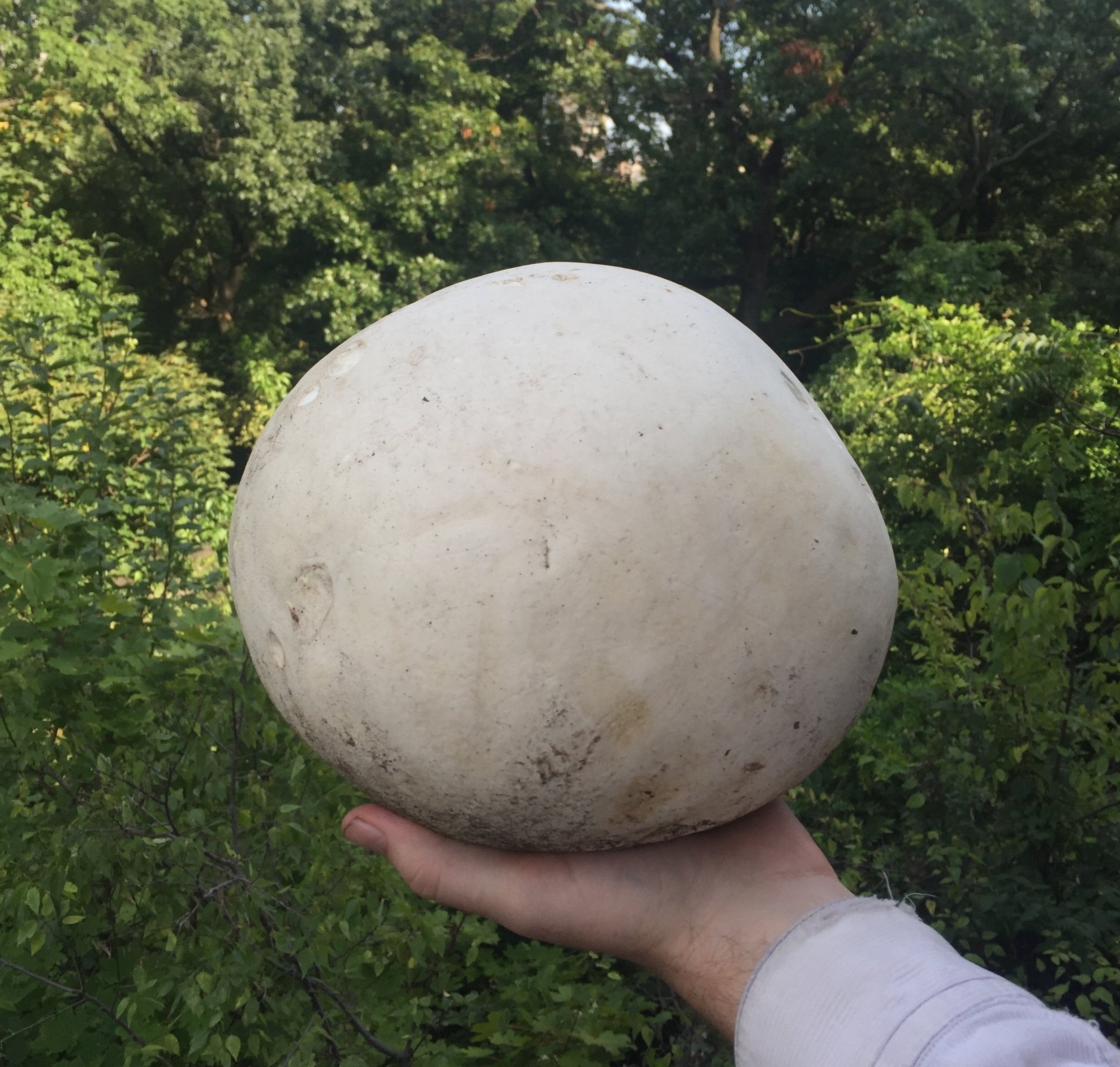The Giant Puffball
The giant puffball mushroom, also known as Calvatia gigantea, is a unique and fascinating mushroom species that is widely distributed throughout the world. As its name suggests, it is a large mushroom that can grow up to several feet in diameter and weigh up to several pounds. In this blog post, we will explore the characteristics, habitat, culinary uses, and potential health benefits of the giant puffball mushroom.
Overview
The Giant Puffball (Calvatia gigantea) is a unique and fascinating species of mushroom. It is a massive, round or oval-shaped mushroom that can grow up to 3 feet (0.9 meters) in diameter and weigh up to 50 pounds (23 kilograms). It has a white to pale yellowish-brown, smooth and firm outer skin, and its flesh is white and spongy. The spore-bearing surface is located inside the mushroom and is a soft, powdery mass that is initially white but eventually turns olive brown.
Giant puffballs grow on soil in open fields, meadows, and forests, usually appearing in late summer to early fall. They are often found in groups, but individual puffballs can grow quite large. They prefer well-draining, nutrient-rich soil, and often grow in areas where there is a lot of decaying organic matter.
The growth rate of the Giant Puffball mushroom can vary depending on environmental factors such as temperature, moisture, and nutrient availability. However, under optimal conditions, the giant puffball can grow quite quickly. When conditions are right, the puffball can grow very large in just a few weeks. It typically appears in late summer or early fall and can grow to its full size in a matter of days or weeks, depending on the soil's availability of nutrients and moisture.
Identification
Identifying the giant puffball mushroom is relatively easy, especially when it has reached maturity. Here are the characteristics to look for when identifying the giant puffball mushroom:
Size and Shape: The giant puffball mushroom can grow up to several feet in diameter and is generally round or slightly oval-shaped. It is larger than most other mushroom species and can weigh several pounds.
Color: The giant puffball mushroom is typically white or cream-colored, with a smooth surface.
Stem: Unlike most mushrooms, the giant puffball does not have a visible stem. Instead, it is attached to the ground by a mass of thick, white, root-like structures.
Spores: When the giant puffball reaches maturity, it will develop a small opening or "mouth" at the top, which will release a cloud of spores when touched or hit.
Habitat: The giant puffball mushroom grows on soil in open fields, meadows, and forests, usually appearing in late summer to early fall. They prefer well-draining, nutrient-rich soil and often grow in areas where there is a lot of decaying organic matter.
Health Benefits
Here are some potential health benefits and medicinal properties of the giant puffball mushroom:
Immune-boosting properties: Like many mushrooms, giant puffballs contain beta-glucans, which have been shown to stimulate the immune system by increasing the activity of natural killer cells and white blood cells.
Anti-inflammatory properties: Giant puffballs contain compounds that have been shown to have anti-inflammatory effects, which may help reduce the risk of chronic diseases such as cancer, heart disease, and Alzheimer's.
Digestive health: The fiber content of giant puffballs can help promote healthy digestion and regular bowel movements.
Nutritional value: Giant puffballs are low in calories and fat, and are a good source of protein, fiber, and vitamins B and C.
While more research is needed to fully understand the potential health benefits and medicinal properties of the giant puffball mushroom, it is generally considered to be a nutritious and tasty ingredient that can be enjoyed as part of a healthy and balanced diet. As with any dietary supplement or herbal remedy, it's important to talk to your healthcare provider before using giant puffball mushrooms for medicinal purposes.
Nutritional Benefits
The giant puffball mushroom (Calvatia gigantea) is generally considered to be a low-calorie and low-fat food, but it is not particularly rich in other nutrients. Here's a brief overview of the nutritional content of this mushroom:
Calories: One cup of sliced puffball mushroom contains only about 19 calories, making it a very low-calorie food.
Protein: Puffball mushrooms are relatively low in protein, containing about 1.5 grams per cup.
Carbohydrates: The carbohydrate content of puffball mushrooms is also quite low, with only about 4 grams per cup.
Fat: Puffball mushrooms are low in fat, with less than 1 gram per cup.
Fiber: Puffball mushrooms are not a significant source of fiber, providing only about 1 gram per cup.
Vitamins and minerals: While puffball mushrooms do contain some vitamins and minerals, they are not particularly rich in any specific nutrient. They do contain small amounts of potassium, phosphorus, magnesium, and vitamin B6.
Overall, while the giant puffball mushroom may not be a particularly rich source of nutrients, it can still be a healthy addition to a balanced diet. As with any food, it's important to consume it in moderation as part of a varied and nutrient-rich diet.
Preservation
Giant puffball mushrooms can be preserved using a variety of methods, including:
Drying: You can dry sliced or cubed giant puffball mushrooms in a dehydrator or in the sun. Once the mushrooms are completely dry, store them in an airtight container in a cool, dry place. Dried giant puffball mushrooms can be rehydrated before using them in recipes.
Freezing: You can also freeze giant puffball mushrooms by slicing or cubing them and placing them in freezer-safe bags. Be sure to remove as much air as possible from the bags before sealing them. Frozen giant puffball mushrooms can be used directly in recipes without thawing.
Canning: You can also can giant puffball mushrooms in a pressure canner. Be sure to follow the instructions for canning vegetables and use a recipe that has been tested for safety.
It's important to note that giant puffball mushrooms are best consumed when they are fresh, as they can quickly develop a strong odor and become unappetizing if they are not properly stored. If you are unsure about how to properly preserve giant puffball mushrooms, it's best to err on the side of caution and consume them within a few days of harvesting.
Fun facts:
The giant puffball is a saprobic mushroom, which means it decomposes dead organic matter in the soil, such as plant debris and dead wood.
The mushroom grows in late summer and early fall in fields, meadows, pastures, and other open areas with well-drained soil.
The giant puffball is edible and has been consumed by humans for centuries. It has a mild, nutty flavor and a meaty texture when cooked.
The mushroom's spores are released into the air when the skin of the mushroom ruptures. This can happen spontaneously or when the mushroom is disturbed by animals or people.
In some cultures, the spores of the giant puffball are used as a natural insect repellent.
The giant puffball has been used in traditional medicine for a variety of purposes, including treating wounds and infections and reducing inflammation.
The mushroom has also been used as a natural dye, producing a yellow color when boiled with alum.
Giant Puffball Pesto Pizza Recipe
Making pizza out of a giant puffball mushroom is a unique and tasty twist on a classic dish! Its also gluten-free and pretty darn healthy. Here is one way to make a puffball pizza with pesto and mozzarella:
Ingredients:
1 giant puffball mushroom
1/2 cup pesto sauce
2 cups shredded mozzarella cheese
1/4 cup olive oil
Salt and pepper to taste
Instructions:
Preheat the oven to 425°F (218°C).
Cut the puffball mushroom into slices about 1/2 inch thick.
Brush both sides of the puffball slices with olive oil and season with salt and pepper.
Place the puffball slices on a baking sheet and bake for 10-12 minutes until slightly tender.
Remove the puffball slices from the oven and spread the pesto sauce over each slice.
Sprinkle shredded mozzarella cheese over the pesto sauce.
Return the puffball pizza to the oven and bake for another 10-12 minutes, or until the cheese is melted and bubbly.
Serve hot and enjoy your unique and delicious giant puffball pizza with pesto and mozzarella!
Note: You can also add other toppings like sliced tomatoes, olives, or mushrooms to the pizza if desired.









